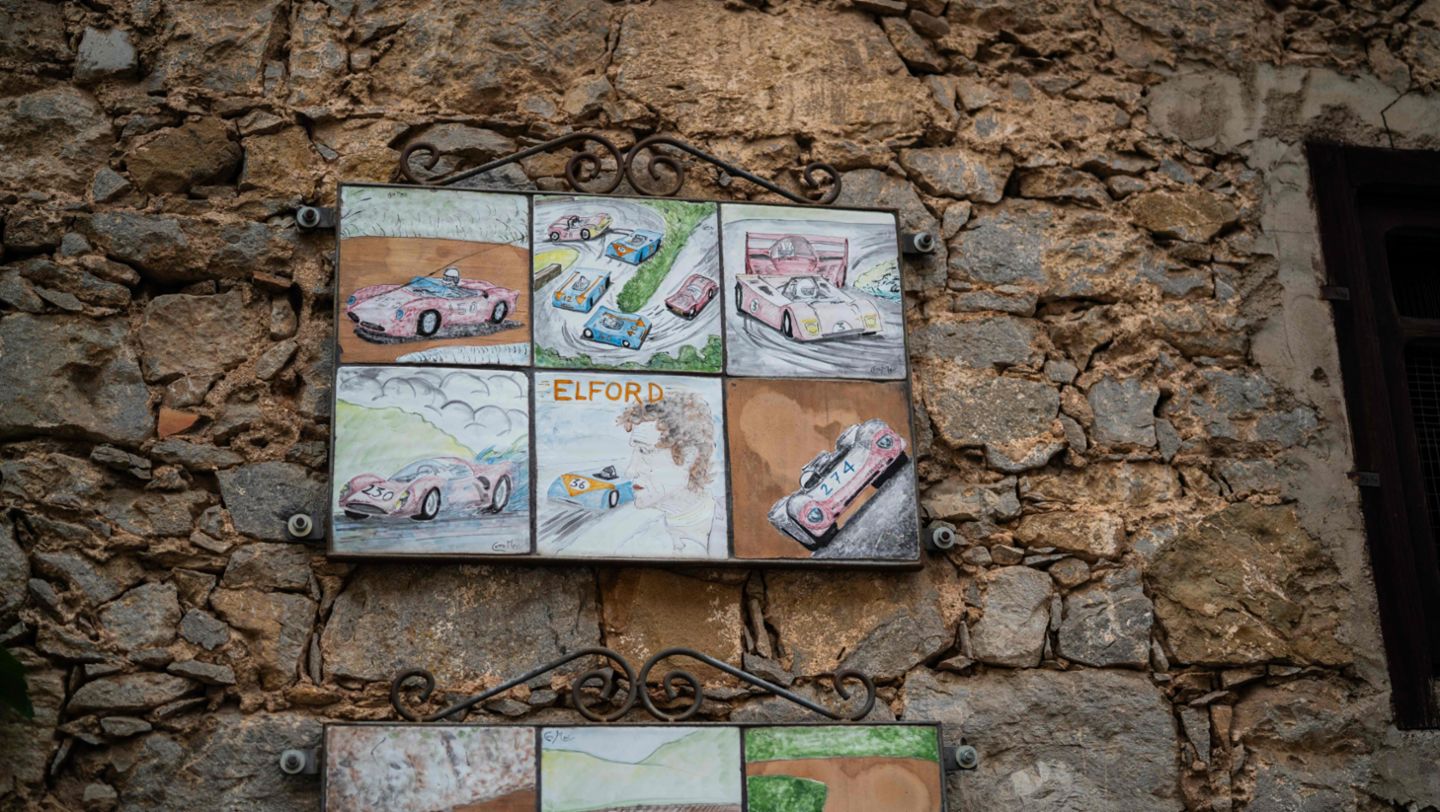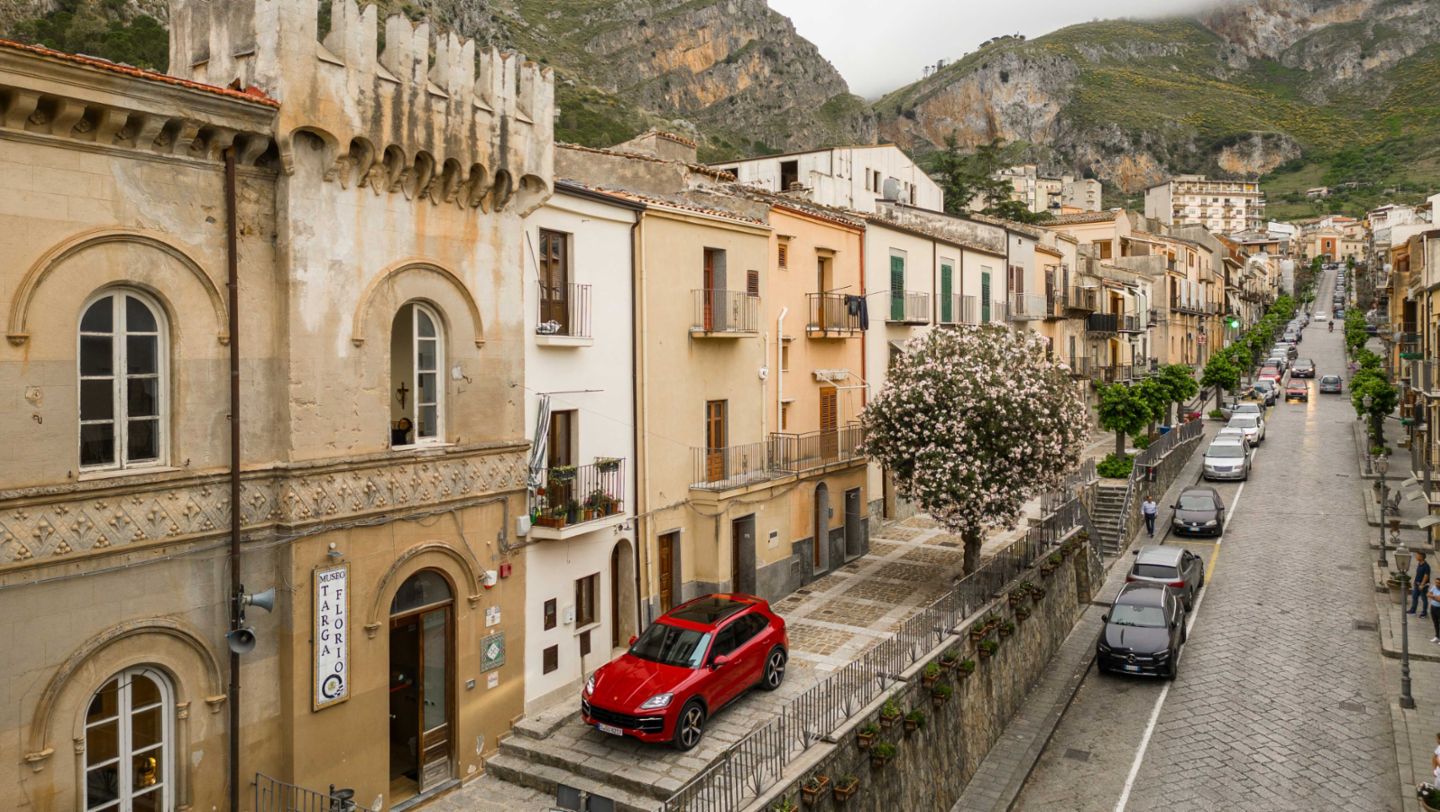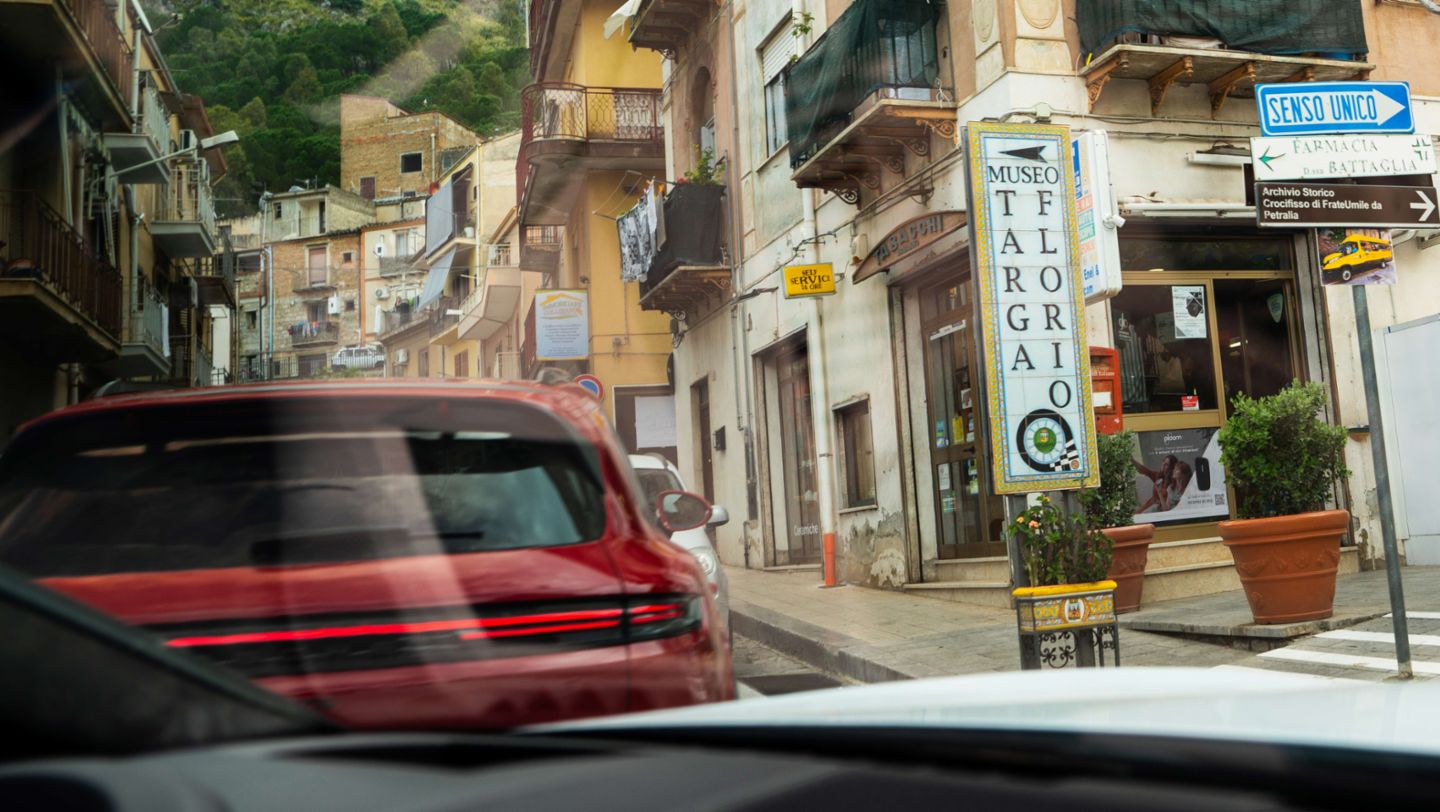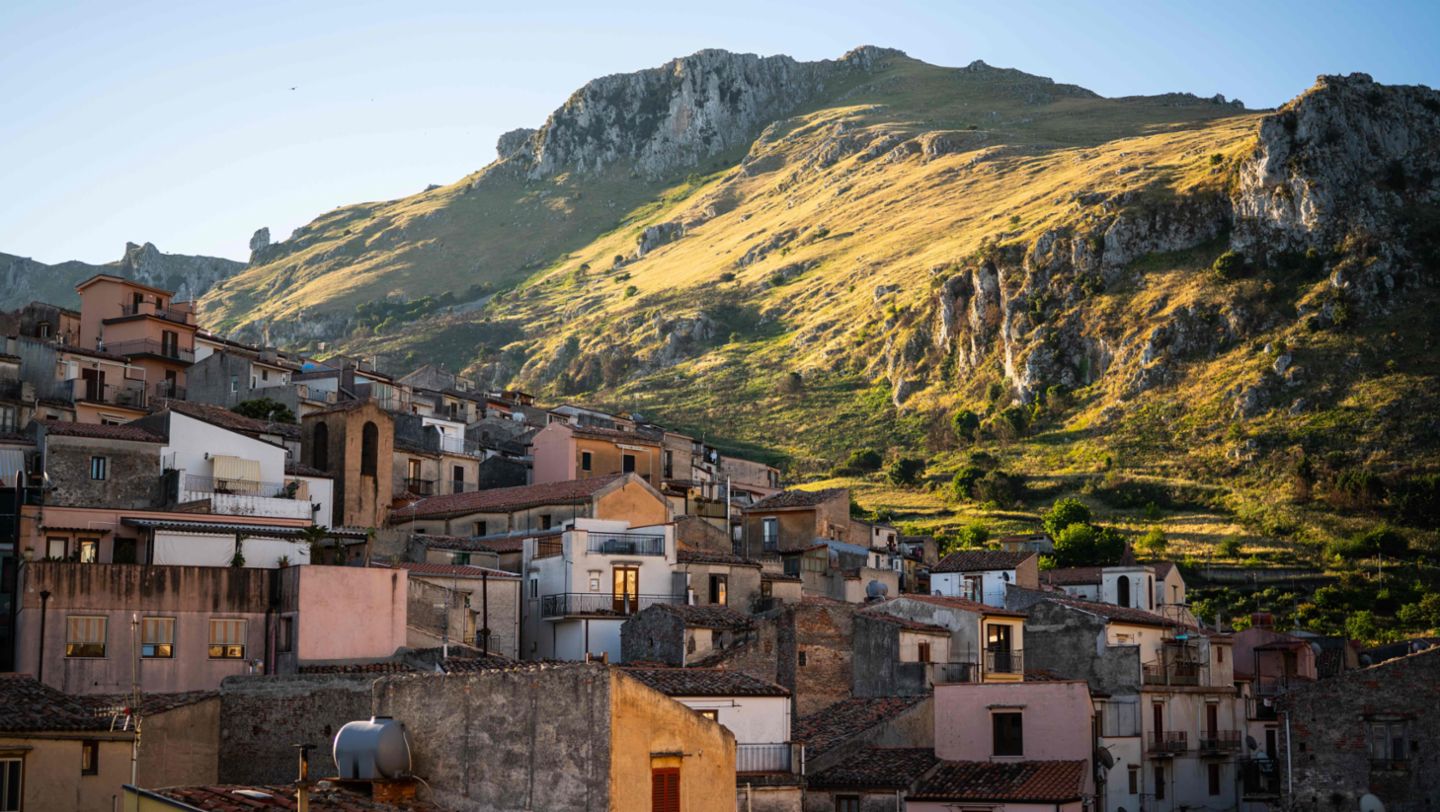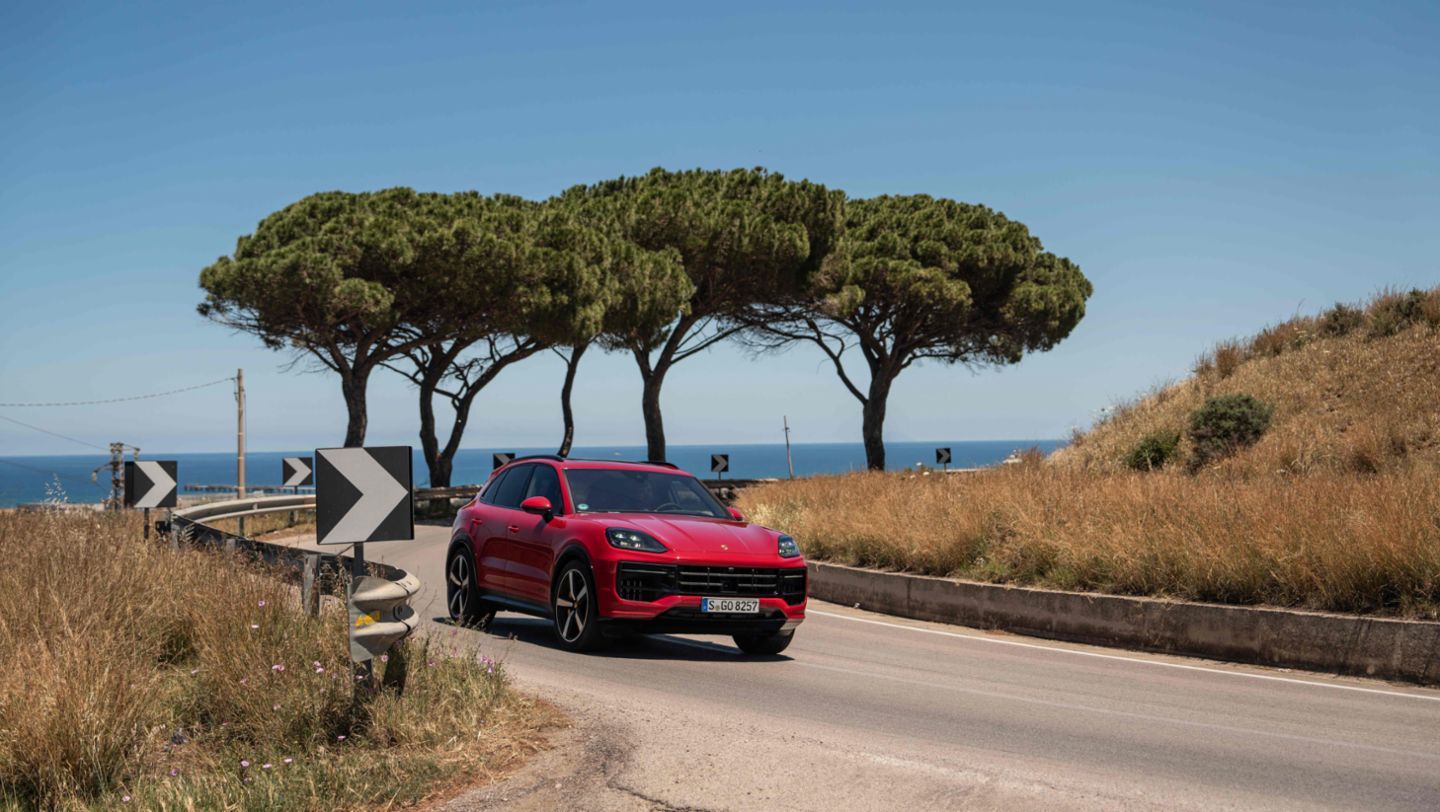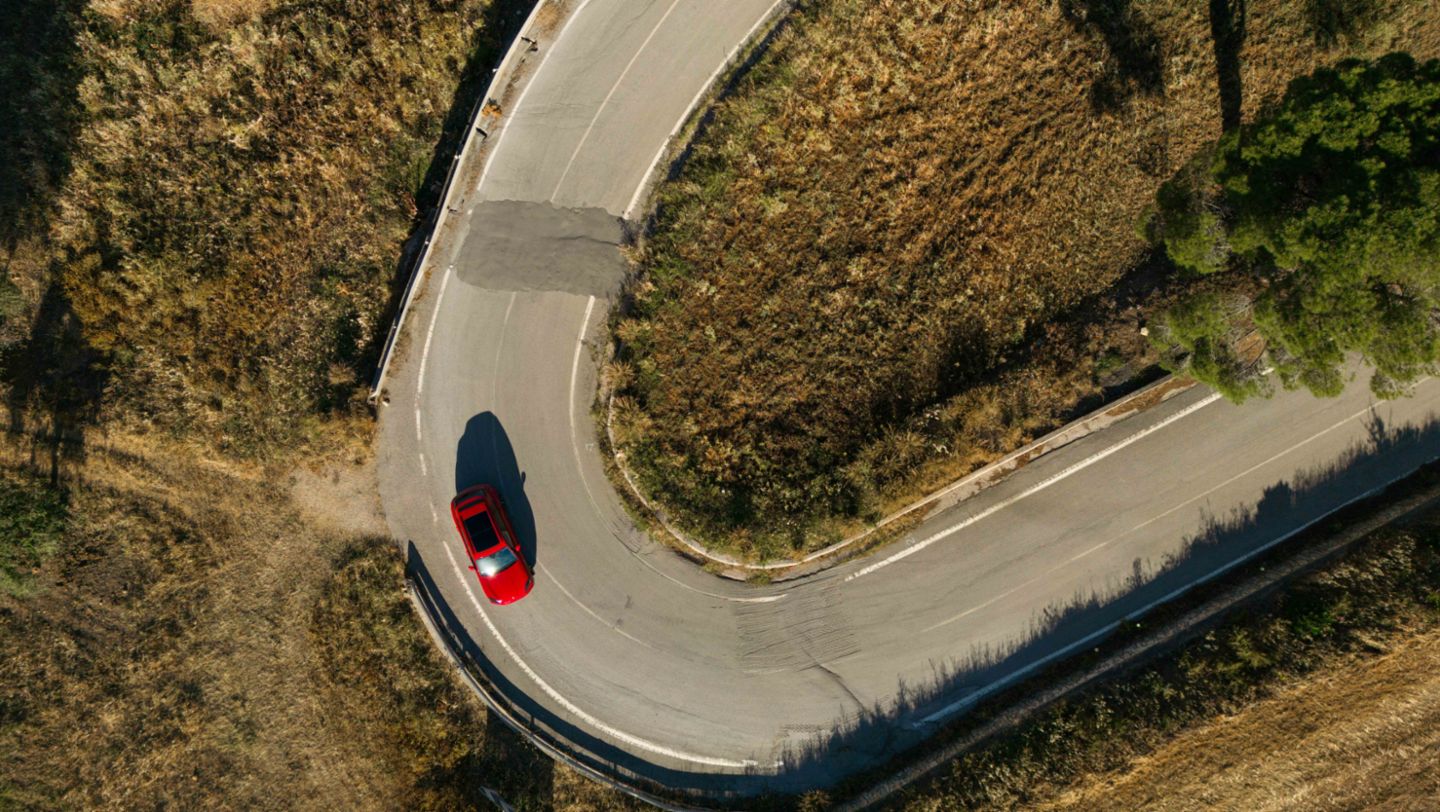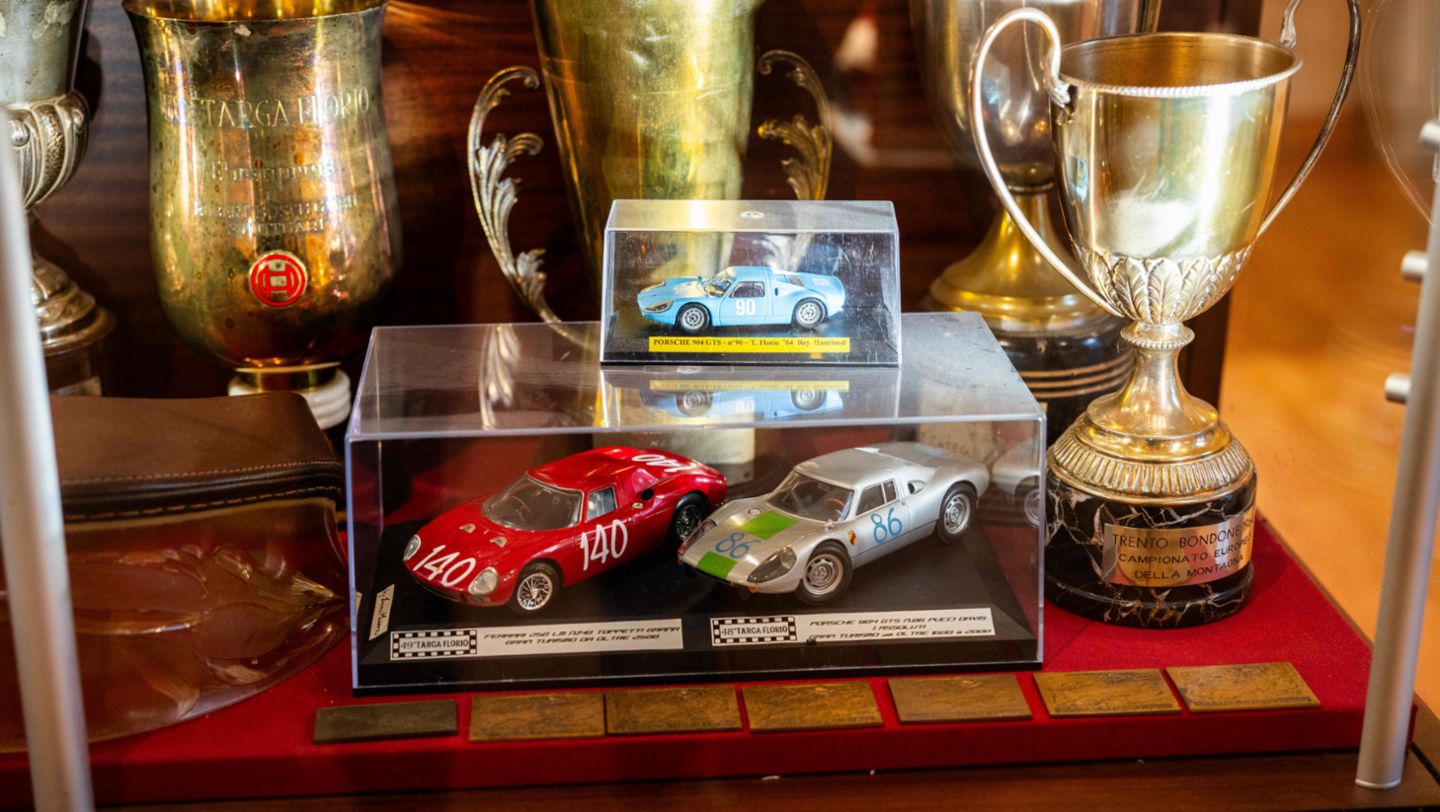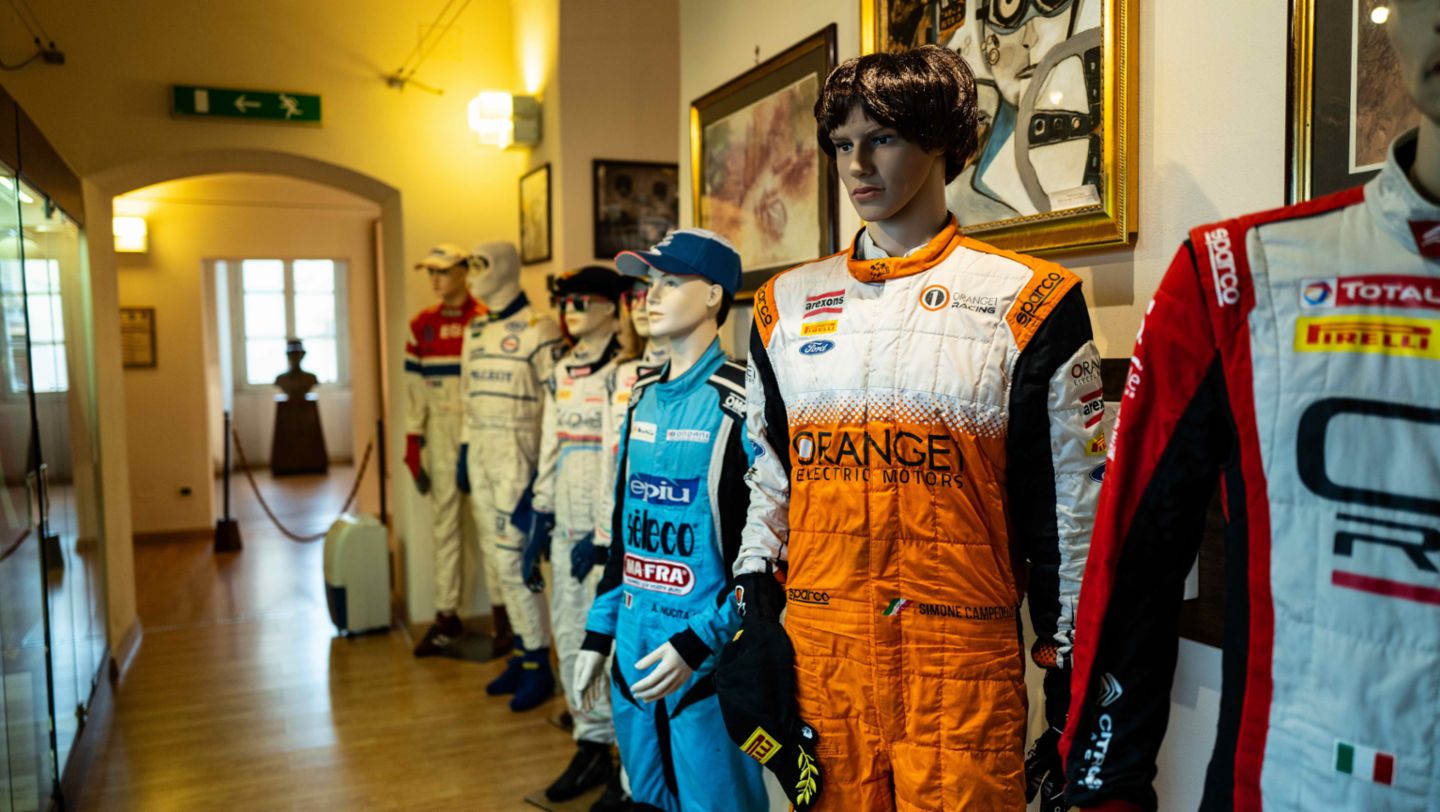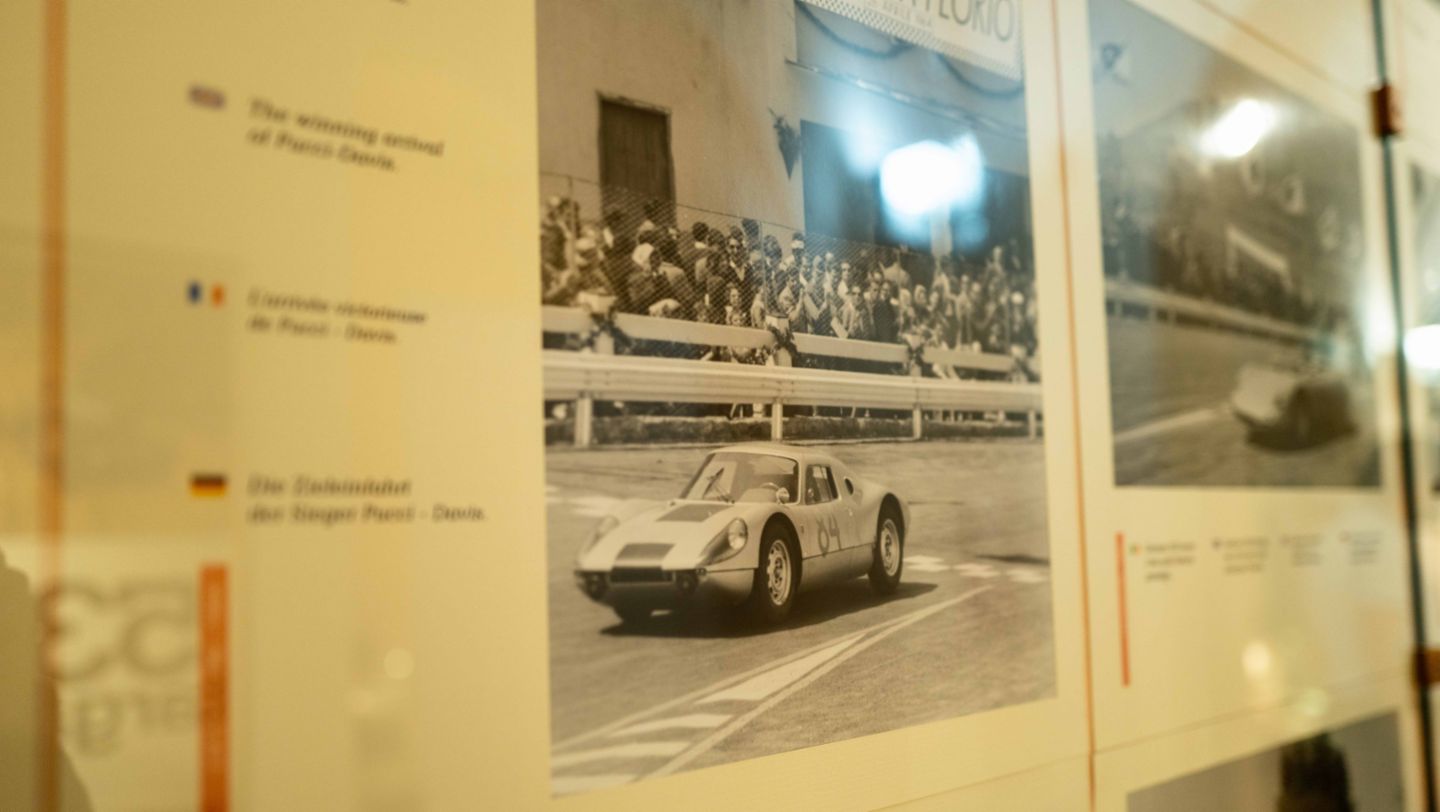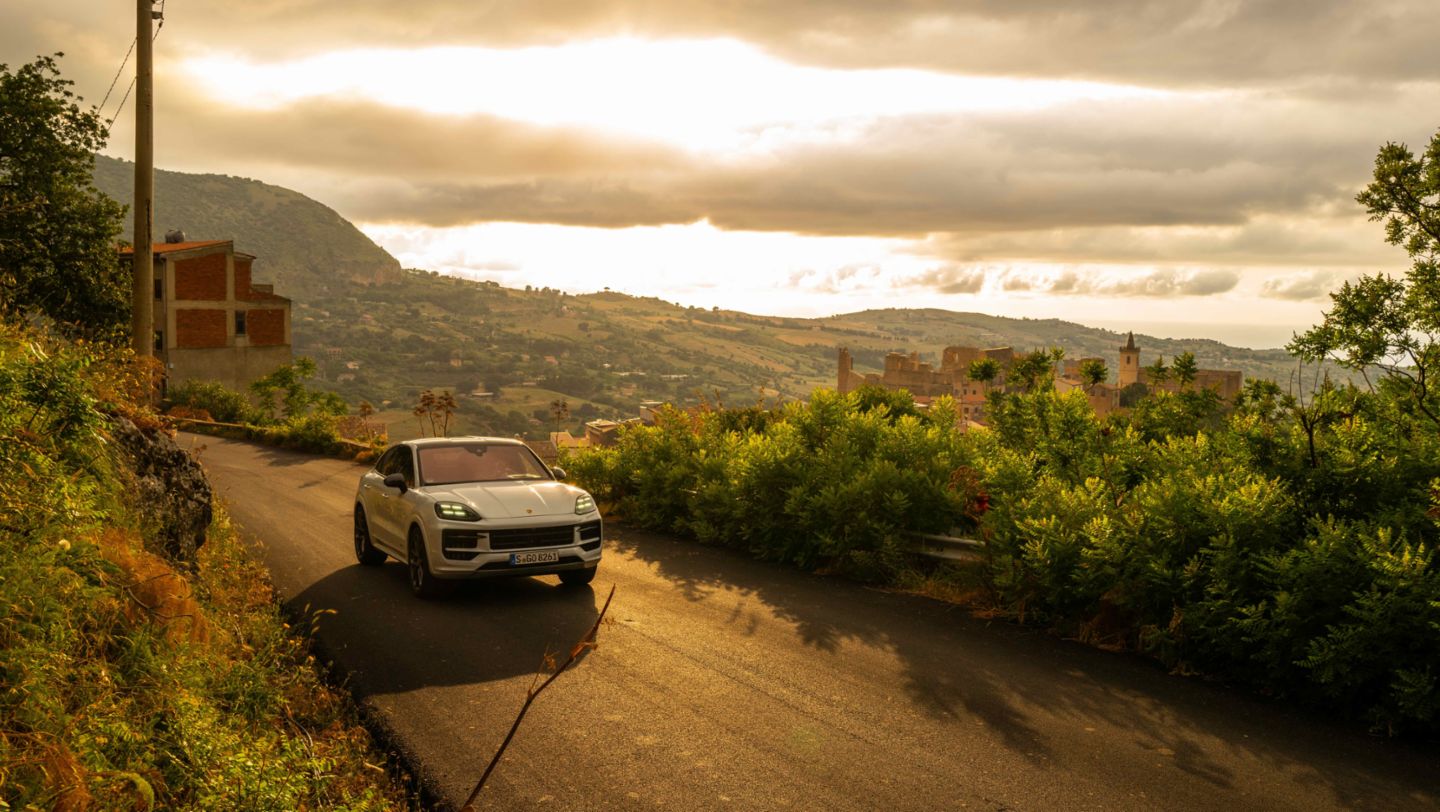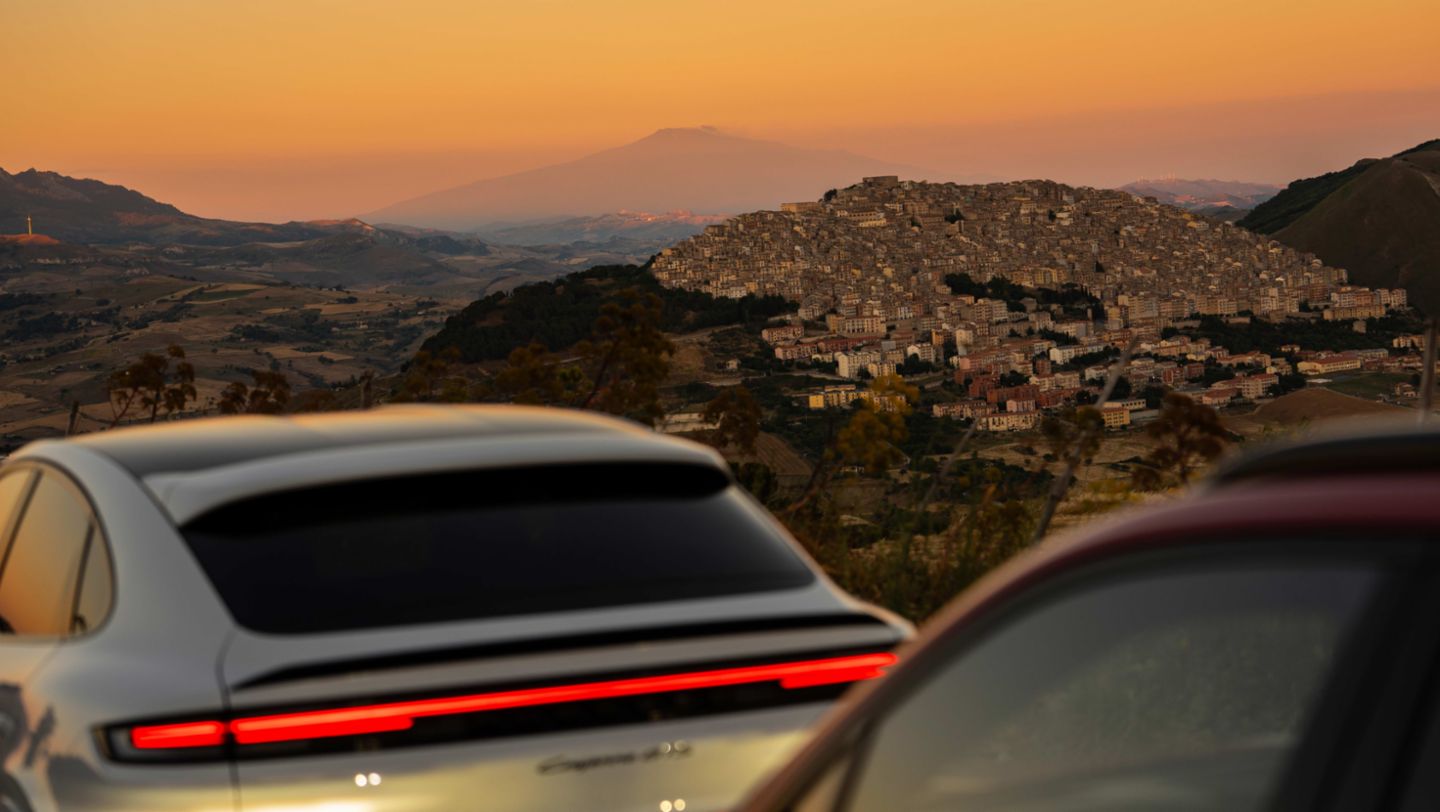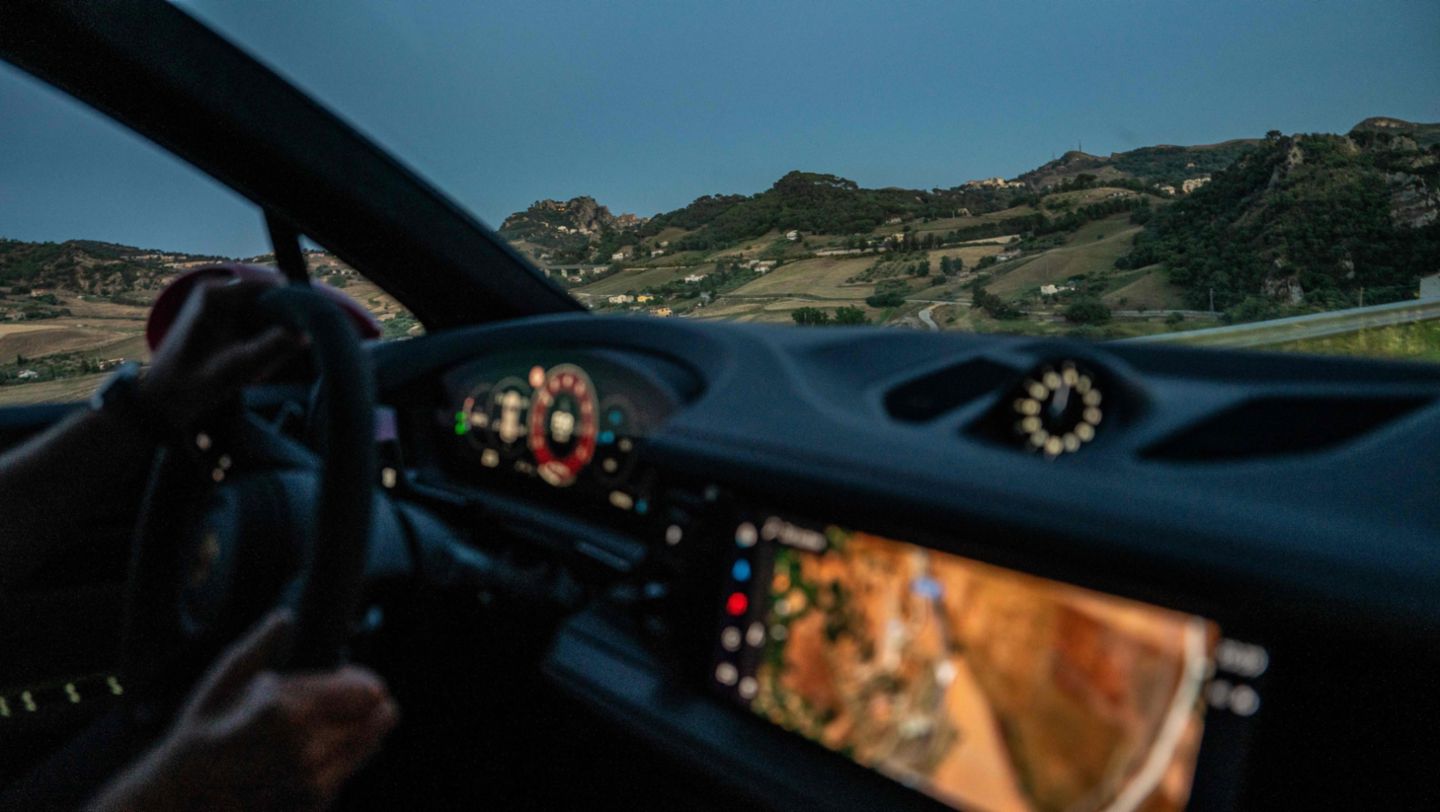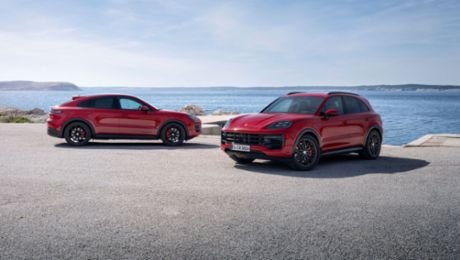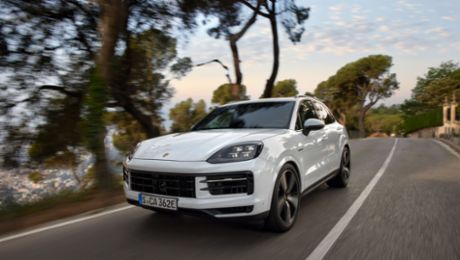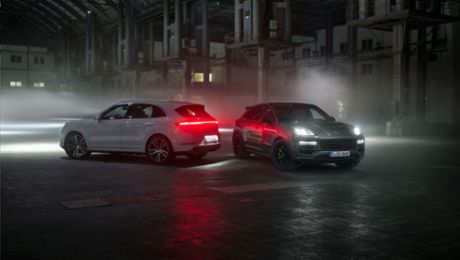The first rays of sunshine are edging ever higher through the windscreen, bathing the landscape in a warm light. Before us lies the historic course of the Targa Florio, a legendary ribbon of asphalt that wends its way through the rugged mountains of the Madonie. Behind us, the wind is blowing across the Tyrrhenian Sea and lashing the waves onto the shore. This part of the Mediterranean forms a triangle between the islands of Corsica, Sardinia and Sicily. On this morning, two Cayenne GTS – a Carmine Red SUV and an SUV Coupé in Carrara White Metallic – are set before an historic backdrop. It’s quiet at the Floriopoli grandstand. The ravages of time gnaw at the old walls. The plaster is crumbling and the advertising lettering is increasingly faded. For some, this place near Cerda with its long straight may be the heart of the Targa Florio. Where the race once started and ended, the atmosphere of the historic rally seems alive to those who close their eyes and remember the motorsport legends of yesteryear.
Back in the present, we make use of digital aids. In addition to countless other dream tours, the “ROADS by Porsche” route planner app also includes the Targa Florio. There is a short historical outline, and the route can be transferred to the 12.3-inch screen of Porsche Communication Management (PCM) via Apple CarPlay or Android Auto.
Thus begins a journey through picturesque villages, over narrow passes and through countless switchbacks. A succession of dense forests and barren sheep pastures pass by to our left and right, olive trees and cypresses line the route. The landscape is wild and mostly untamed. We experience a mix of challenging mountain roads and breathtaking views that captivated drivers and fans alike from 1906 to 1977 – albeit in the last few years no longer as a World Sportscar Championship race. Every kilometre tells the tales of effort, the tireless pursuit of speed and perfection – and, in the case of Porsche, also of fame.
60 years of overall victory in the Targa Florio – a look back at the king of curves
7:10:53.300. Seven hours, ten minutes, 53 seconds and two blinks of an eye at the absolute limit. The day on which local favourite Antonio Pucci and Colin Davis won the Targa Florio was 60 years ago. On 26 April 1964, they crossed the finish line in a silver Porsche 904 Carrera GTS Coupé more than 13 minutes ahead of their second-placed teammates Gianni Balzarini and Herbert Linge, who also competed in a four-cylinder model. By then, the Italian-British works team in car number 86 would complete ten laps and cover a total distance of 720 kilometres on the Sunday in question. In the process, they navigated some 8,000 bends with an average speed of 100 km/h. The route runs counterclockwise through the Madonie, a mountain range in northern Sicily. Driving a 904 Carrera GTS with an eight-cylinder boxer engine and 240 PS, Edgar Barth and Umberto Maglioli won the prototype class in the 1964 Targa Florio. Porsche celebrated a 1-2 victory.
Ten years later, the race was scratched from the World Sportscar Championship series for safety reasons. To this day, the Targa Florio is held as a rally event and still relies heavily on the original routes. The Targa Florio Historic Regularity Rally is all about uniformity, not speed. And yet the modern interpretation of the event keeps the tradition and spirit of the former road race alive.
Test for speed, endurance and skill
With our two Cayenne GTS, driving at the limit is out of the question during today’s tour. It is quite enough to experience the past in the present day with the descendants of the overall winner from 1964. Re-tracing the routes of the legendary Targa Florio also means imagining what it would be like to master the 800 turns per lap in a race against the clock. Visualising how the steep climbs and abrupt descents pushed both car and driver to their limits. From its founding by Conte Vincenzo Florio in 1906, the Targa Florio has not only been considered a test of speed, but also of the endurance and skill of both human and machine. With the overall win six decades ago, it was not just the two-seater coupé with a mid-engine and glass-fibre-reinforced plastic body that made history, but also the concept of the “Gran Turismo Sport”.
If the acronym “GTS” initially referred to an increase in comfort in a thoroughbred racing car, in time it would come to signify heightened sportiness with the usual high level of comfort. In the 1980s and 90s, the 924 and 928 sports car models were upgraded in their own “GTS” versions before Porsche retired this resonant lettering. The inspiration for today’s GTS models from Porsche comes from the sports car manufacturer’s first SUV: The first Cayenne GTS was presented at the IAA in Frankfurt in 2007. It had a V8 engine with modified intake and 298 kW (405 PS), as well as a manual six-speed transmission. Chassis optimisations significantly boosted longitudinal and transverse dynamics. The striking exterior and the gritty V8 sound are still fondly remembered to this day. The success of the Cayenne GTS motivated Porsche to extend the concept to other models. Today, each series has at least one GTS variant. This applies to the classic combustion engine models and the all-electric Taycan.
Corners, culture and cobblestones
While we drive the new Cayenne GTS through the switchbacks of the largest Mediterranean island without time pressure and without cheering spectators at the edge of the road, the standard air suspension and ten-millimetre-lower chassis forms the perfect basis for both high comfort and dynamic precision. The adaptive shock absorbers of the Porsche Active Suspension Management (PASM) and their innovative two-valve technology effectively insulate passengers from the countless bumps in the highly variable asphalt. At the same time, the off-road-capable SUV proves that it is also a dynamic sports car at every turn between Cerda and Caltavuturo. A major contribution is made by the steering knuckles on the front axle, which increase the negative camber of the wheels by 0.58 degrees compared to most other Cayenne models. The result is strikingly direct cornering behaviour and exceptional transverse dynamics, which can be experienced at the wheel of the Racetex-covered GT sports steering wheel. The standard Porsche Torque Vectoring Plus (PTV Plus) provides additional driving stability.

When re-tracing the course of arguably the most spectacular endurance race in the world, a visit to Via Polizzi 2 should not be missed. One of the most striking turns of the Targa Florio awaits drivers in Collesano, 70 kilometres east of Palermo. A hairpin bend leads around an old building, surrounded by steep slopes from which spectators once cheered the racers. Just under 4,000 inhabitants live in the village, which is known for its colourful wall tiles. In many places, these works of art are reminiscent of the most important victories and drivers of the Targa Florio. The Town Hall is situated on Corso Vittorio Emanuele, a picturesque cobblestone street, to the right of which is the entrance to the Targa Florio Museum. Monte Cucullo looms in the background. The small but exquisite museum houses an impressive collection of photos and many documents about the long-distance race, memorabilia and devotional items.
There and on the countless information boards on the side of the road, one learns that the route of the Targa Florio has been changed several times in the course of its history and today is divided into three distances: The 72-kilometre circuit, the “Piccolo Circuito delle Madonie”, is the shortest but most frequently driven. The 108-kilometre “Circuito Medio” and the 148-kilometre “Circuito Grande” are also well worth a try. The latter leads through the small town of Petralia Sottana, located on a rocky outcrop, the birthplace of Baron Pucci, the winner of the 1964 rally. High time for an espresso and pistachio ice cream in the narrow streets lined with historic façades.

Symbiosis of the past and present
Driving the historic route of the Targa Florio with the new Cayenne GTS feels like the combination of the motor racing past with the technical possibilities of the present day. The impressive landscape of Sicily joins forces with the modern engineering acumen of Porsche. The Cayenne GTS makes full use of its strengths along the way. In addition to its particularly sporty suspension, the eight-cylinder biturbo engine with four litres of displacement is another important feature. After a thorough upgrade, the now 368 kW (500 PS, Cayenne GTS: Fuel consumption* combined (WLTP) 12.7 – 12.2 l/100 km, CO₂ emissions* combined (WLTP) 289 – 277 g/km, CO₂ class G ) V8 is even more efficient and powerful.
Accelerating out of the countless hairpin bends is a real pleasure. 660 Nm of torque, the short reaction and shifting times of the revised eight-speed Tiptronic S, and an emotional V8 concert via the standard sports exhaust system create a pure GTS feeling.
To ensure that the drivetrain of the Cayenne always remains “cool” on the winding mountain roads of Sicily as well as on a circuit, even with a sporty driving style, the transfer case of the all-wheel drive has its own water cooling circuit.
The rugged rocks of the Madonie range provide a dramatic, ever-changing backdrop. Suddenly, the landscape opens up and offers a view of the glittering sea in the distance. Before we turn back towards the Floriopoli grandstand, the first straight in a good while opens up outside Campofelice di Roccella. The cars of yore in the Targa Florio hit their top speeds on the Buonfornello straight, which cruises along the coast for six kilometres. Notwithstanding the 275 km/h that the new Cayenne GTS 275 km/h could reach, we stick to the modern 70 km/h limit on the two-lane superstrada and enjoy our Sicilian journey in time in relaxed style.
At its end, the road trip is not just a tribute to the glorious past of the Targa Florio, but also a celebration of the present. With each kilometre we cover, we feel a connection to the drivers who have made history while also reflecting on the technical innovations that enable us, taking the example of the new Cayenne GTS, to handle the historic bends not only with dynamic performance and precision, but also exceptional comfort and relaxation. The very definition of Gran Turismo Sport. The Targa Florio lives on not only in stories, but in all those who have experienced the route for themselves. And who then tell their own story.
Info
Copyright: The historical images published in this article are subject to copyright. Reproduction in whole or in part is not permitted without the written authorisation of Dr. Ing. h.c. F. Porsche AG. Please contact newsroom@porsche.com for further information.
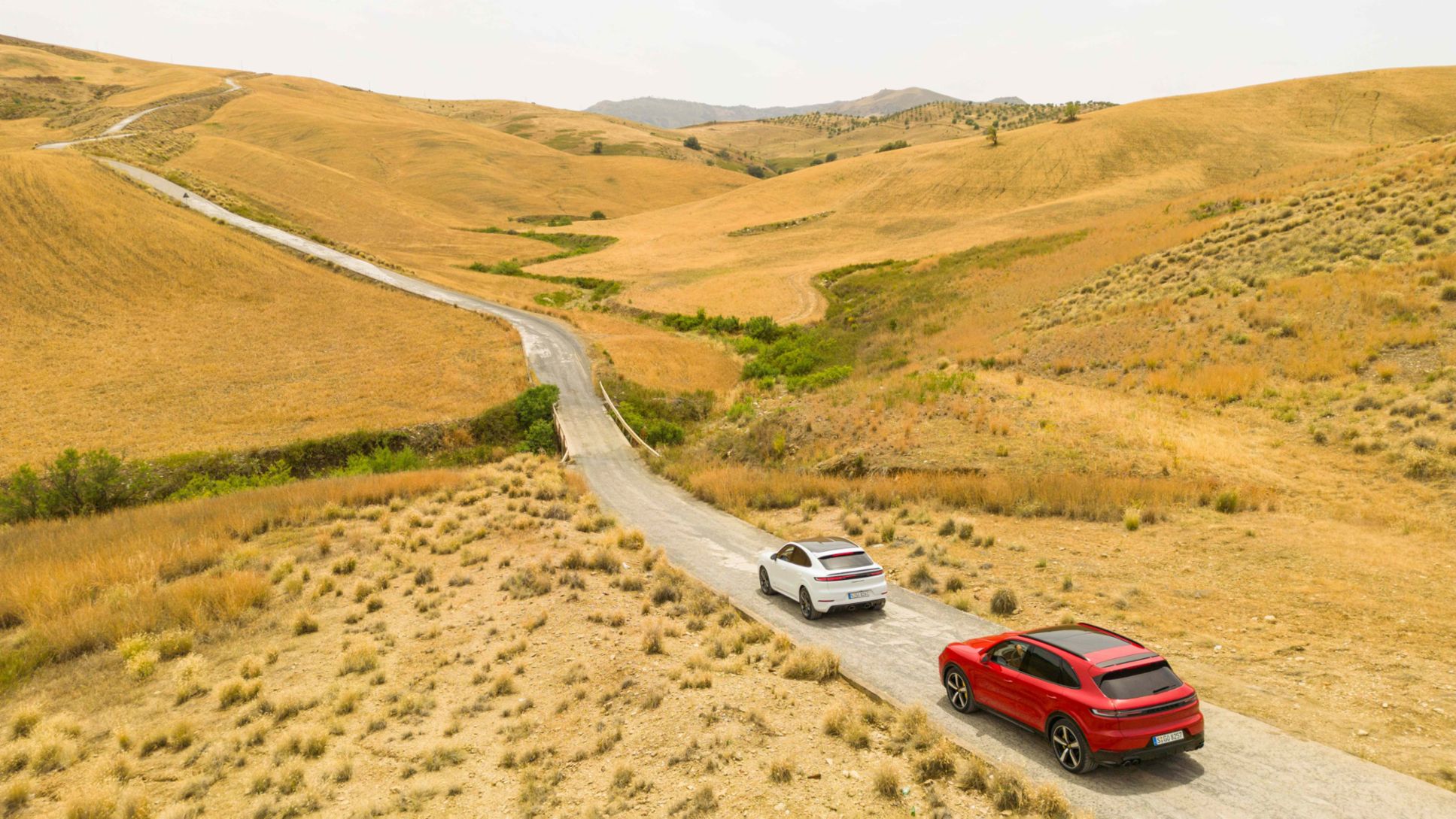
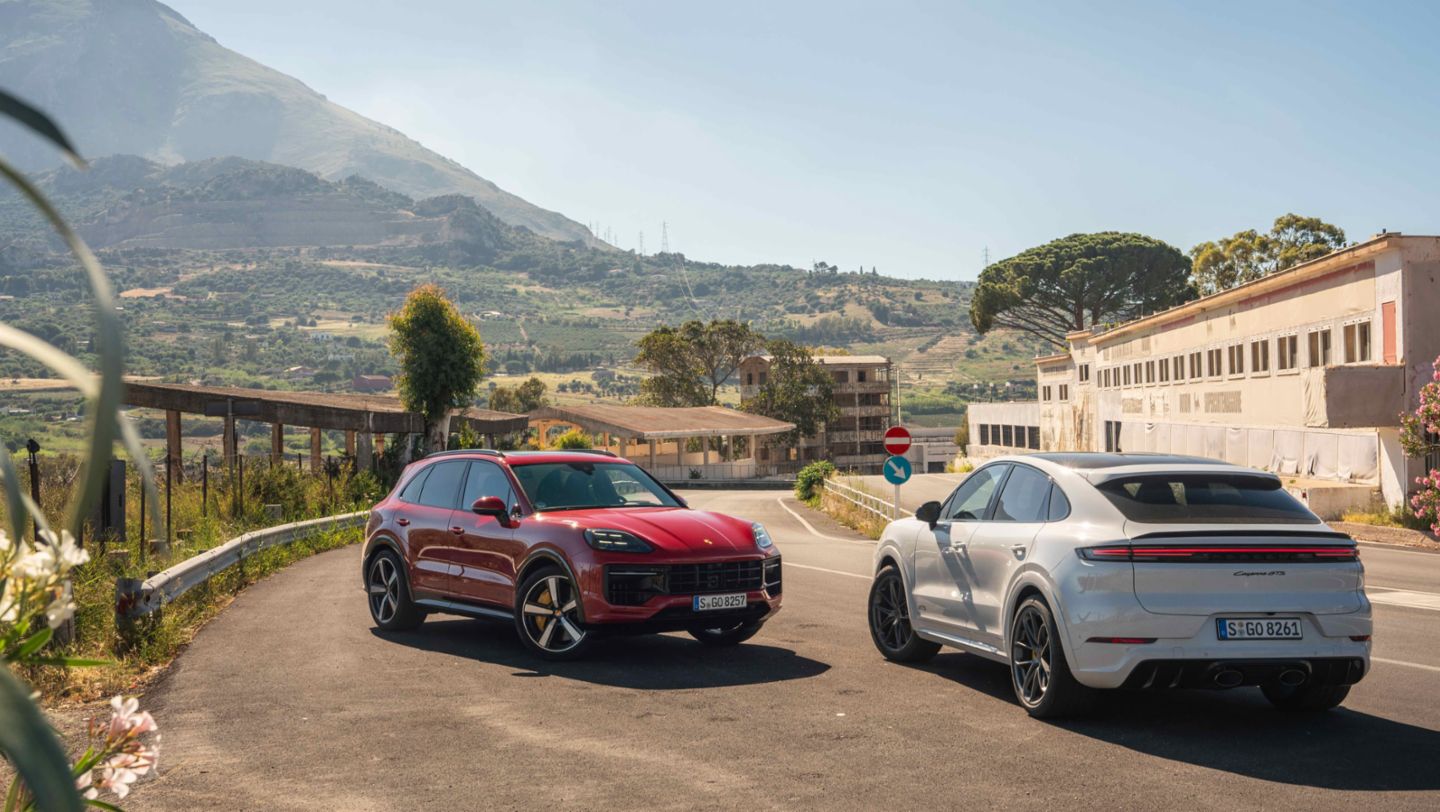
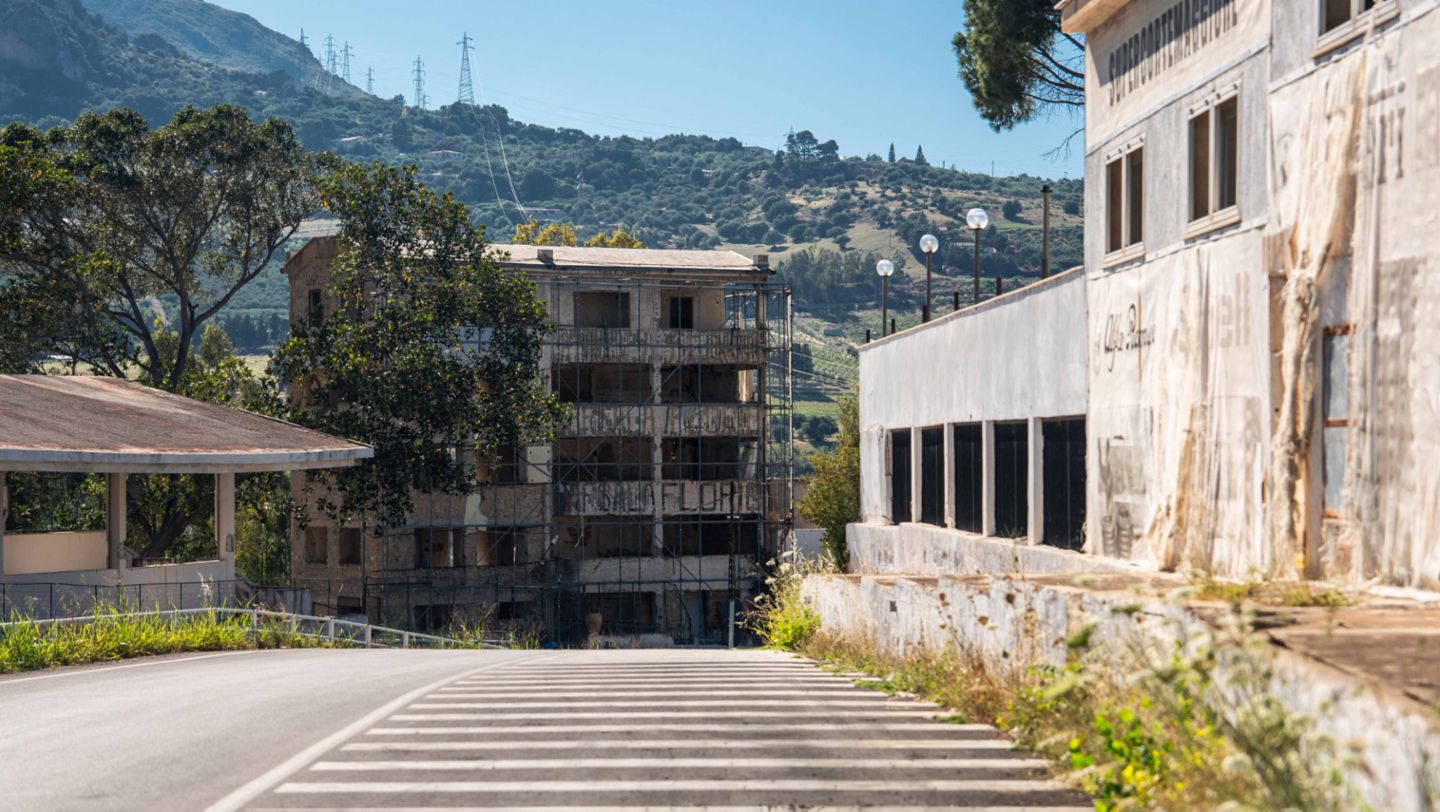
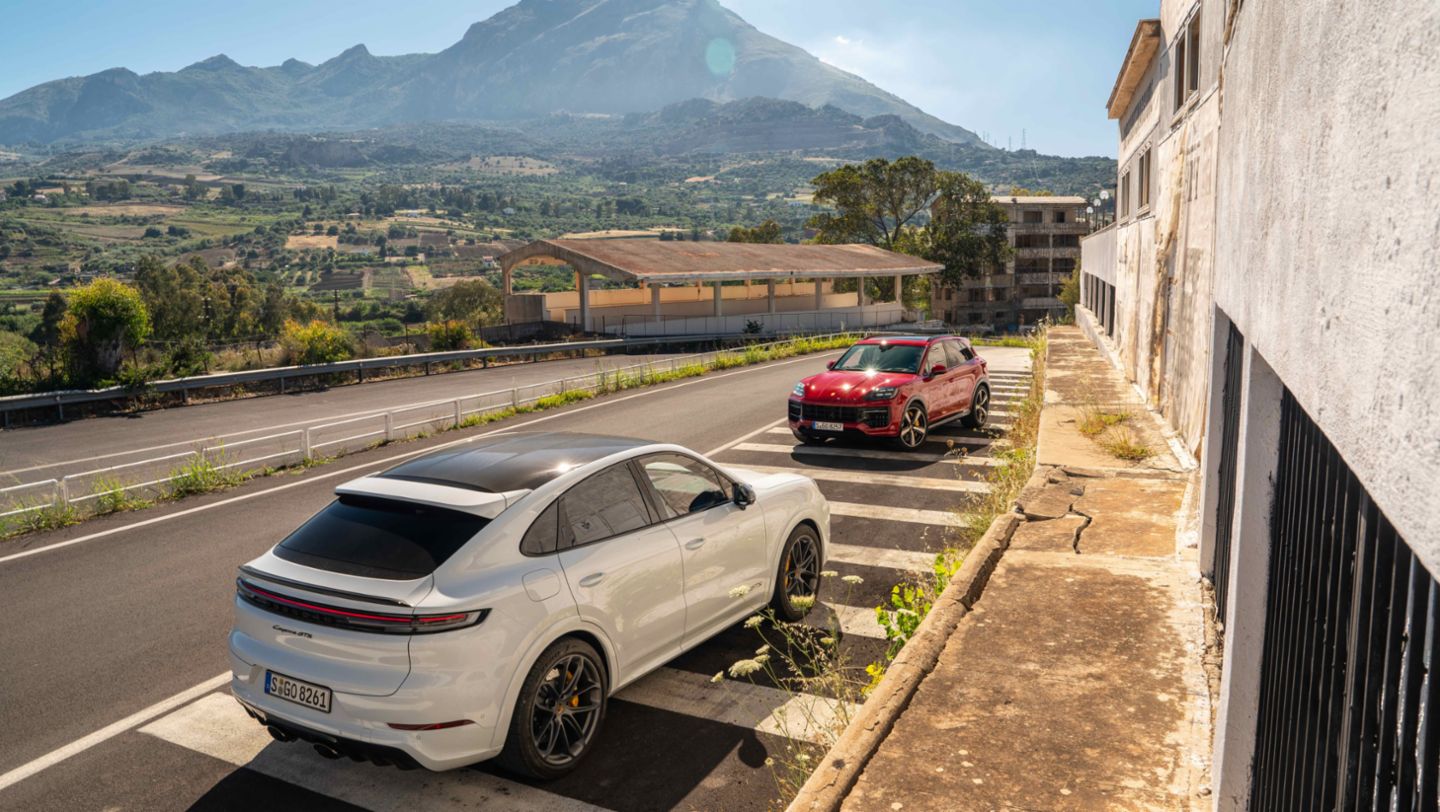
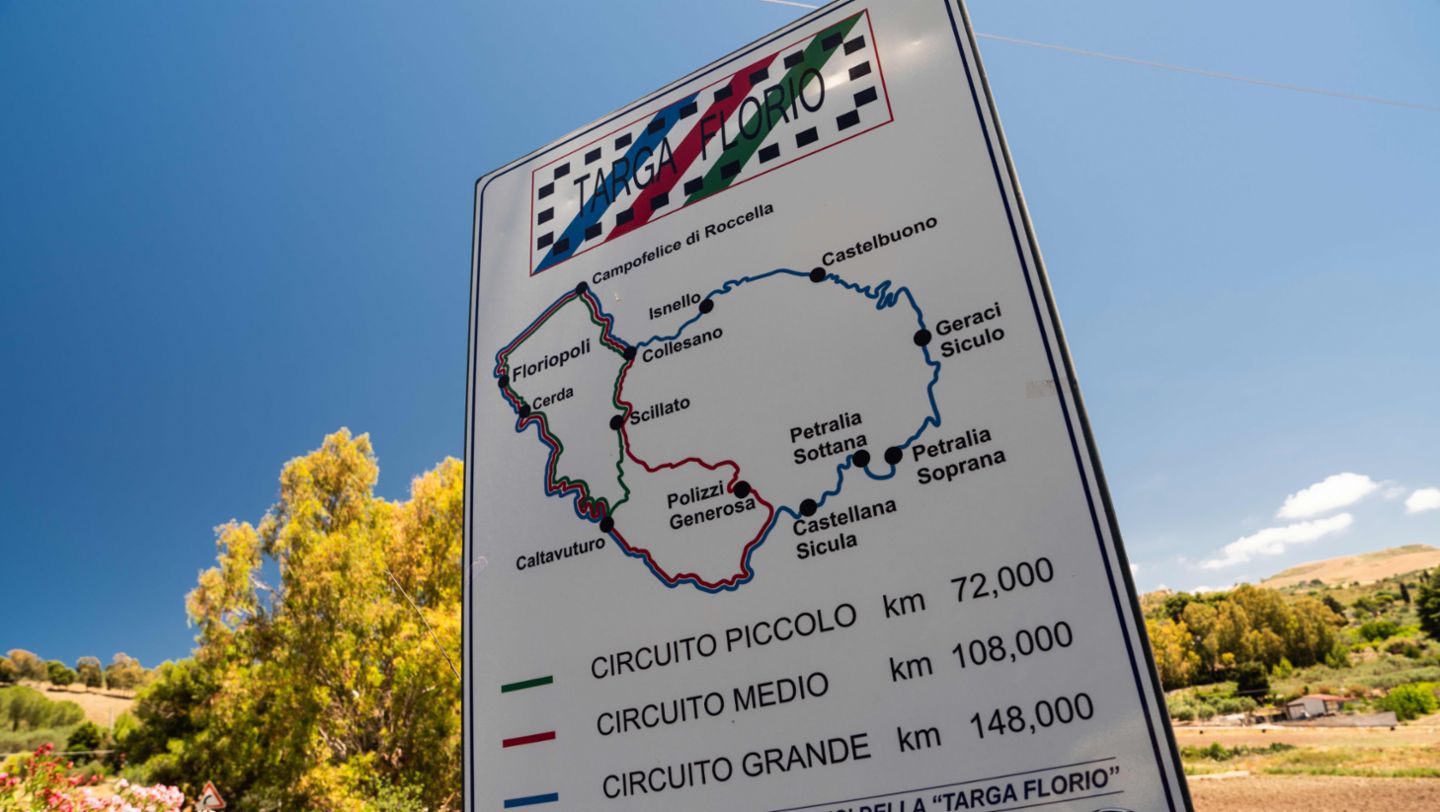
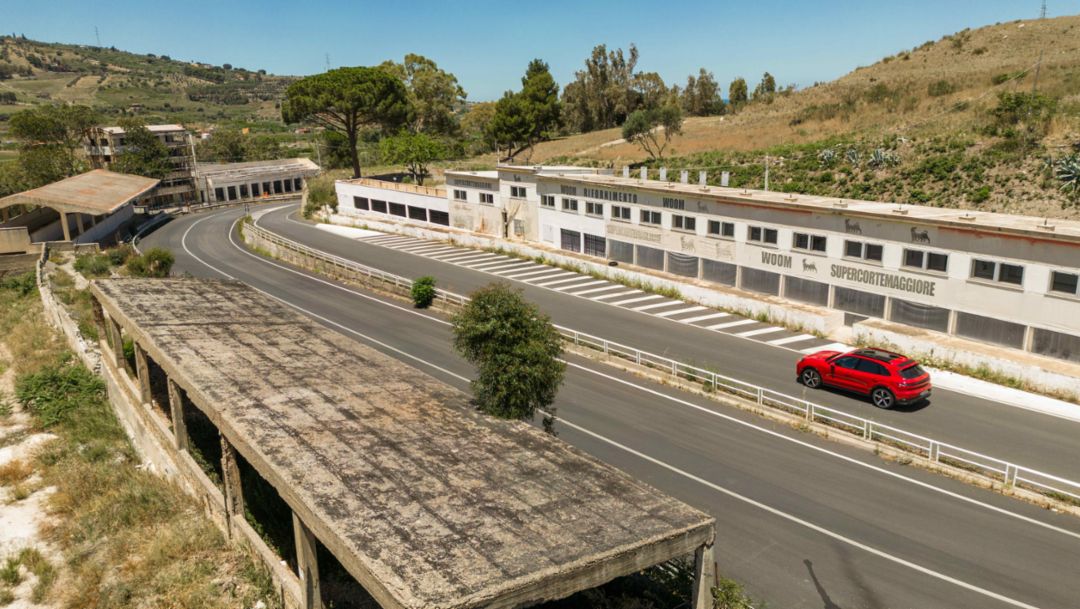
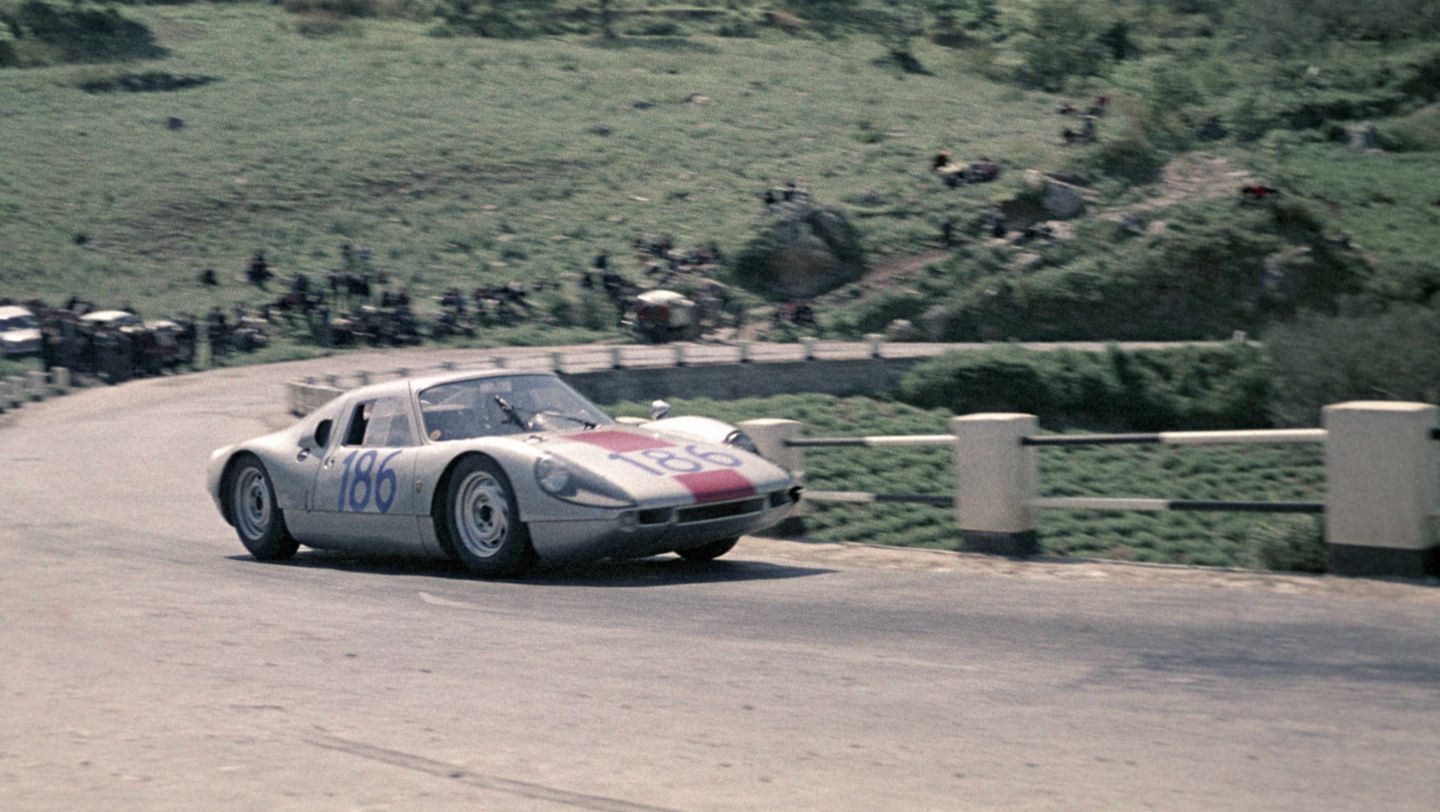
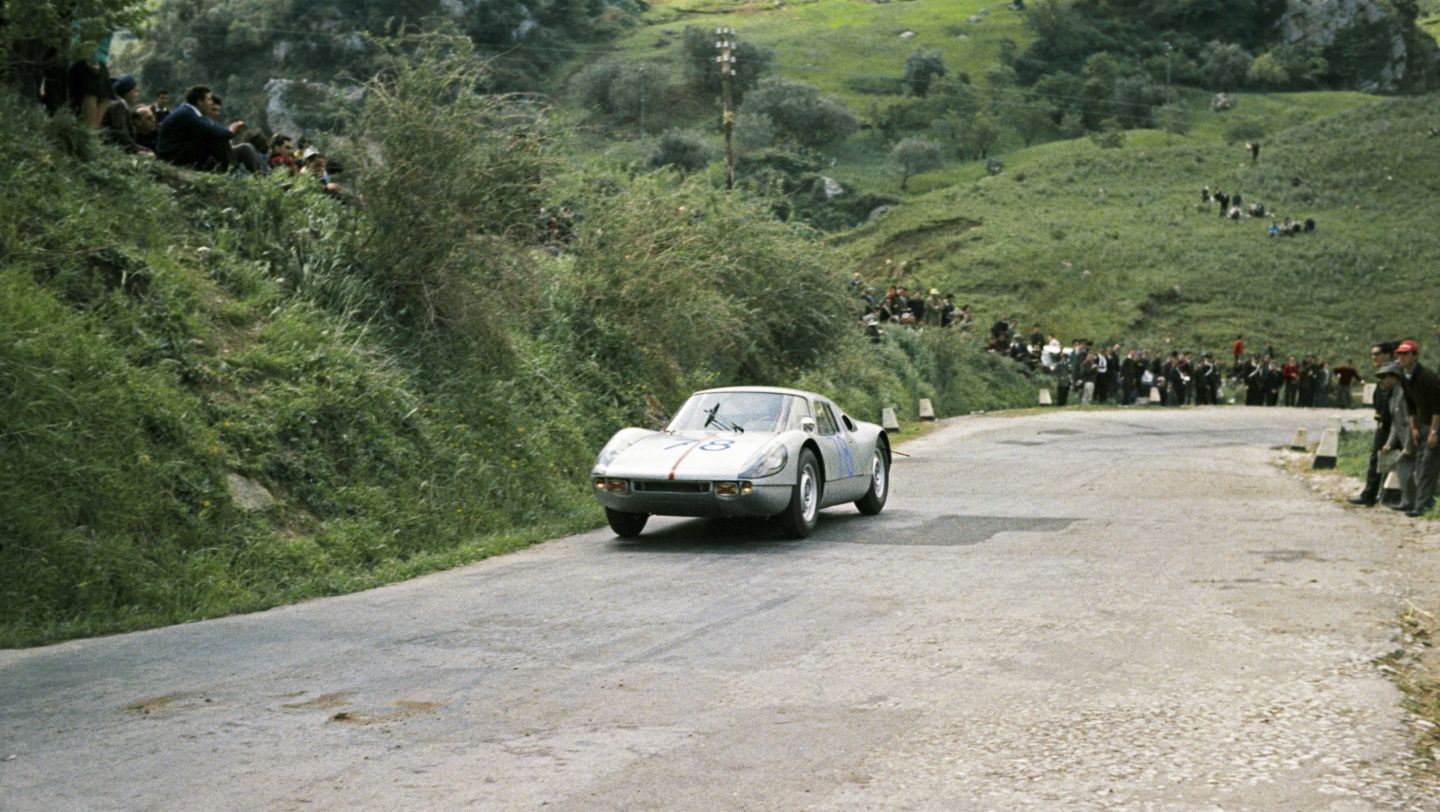
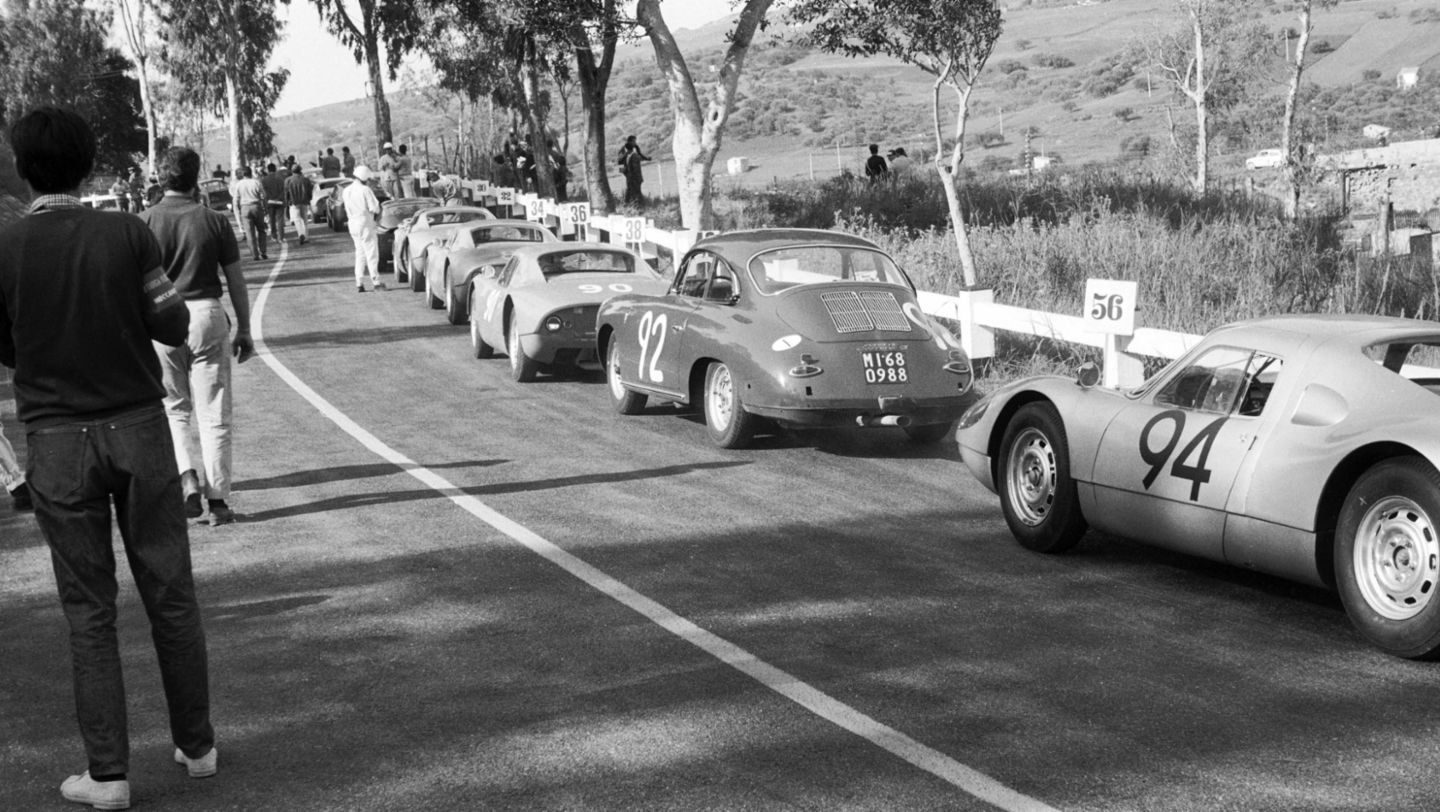
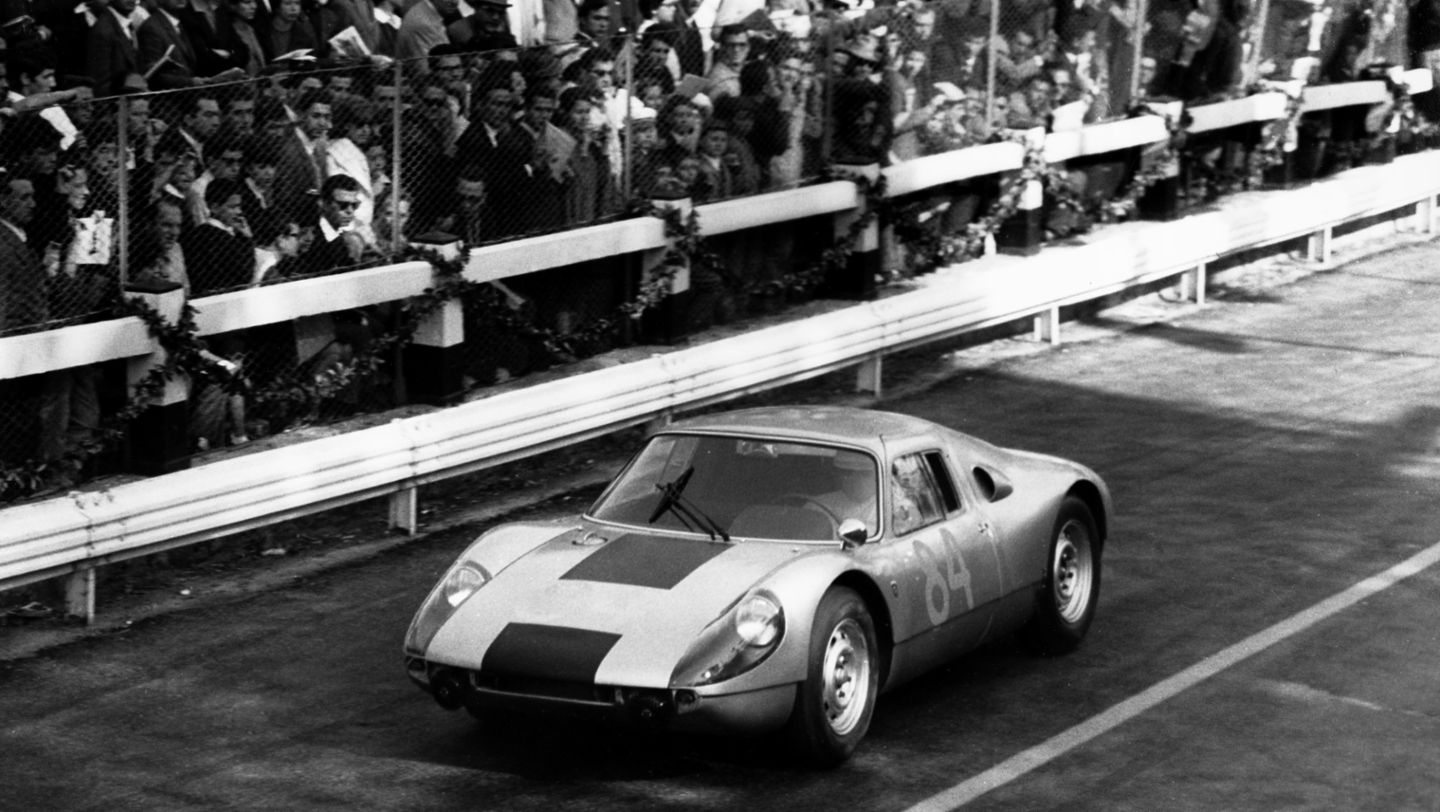
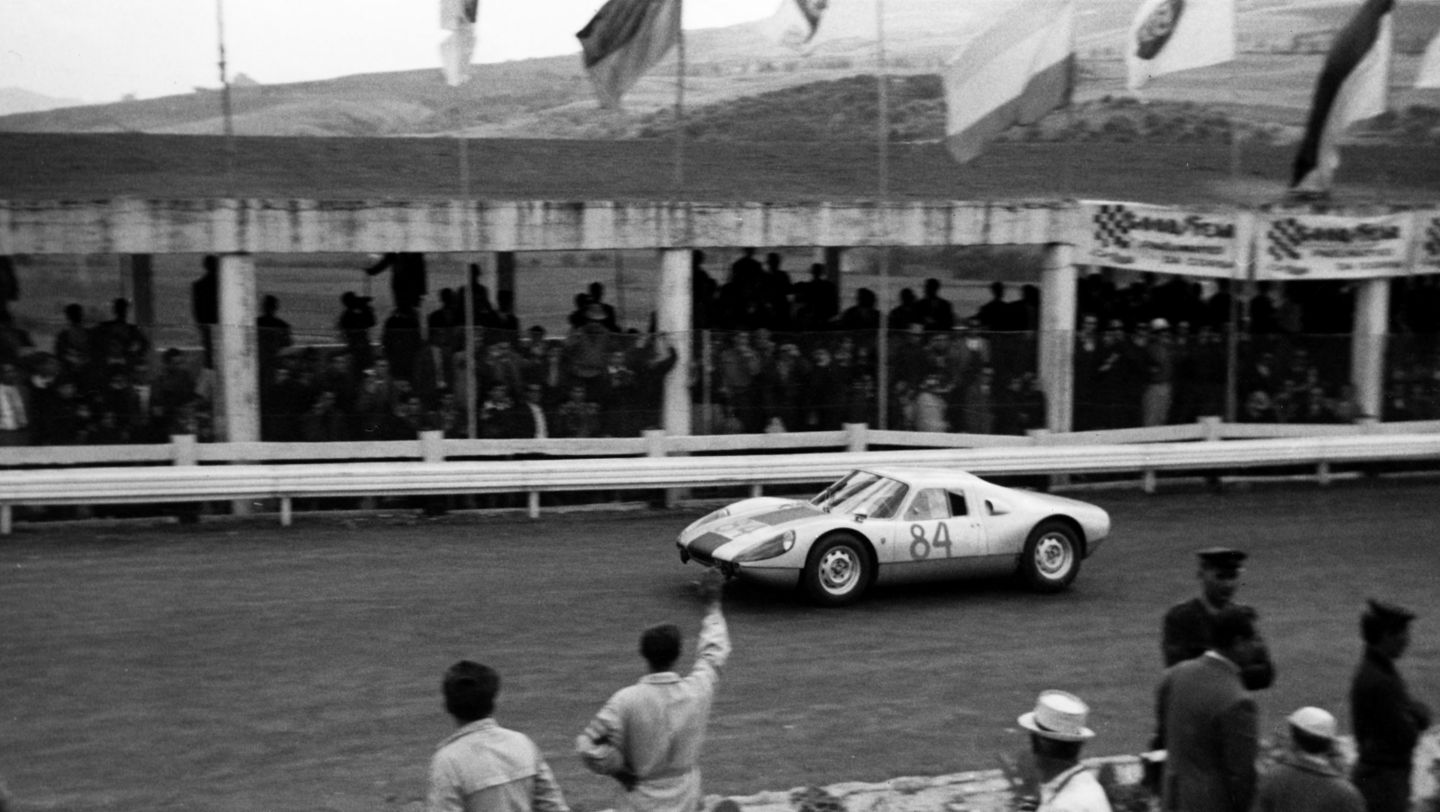
.jpg/jcr:content/Targa-Florio-1964;-Porsche-Rennfahrer-Colin-Davis-und-Baron-Antonio-Pucci-auf-Porsche-Typ-904-(1.-Pl.Ges.kl.).jpg)
